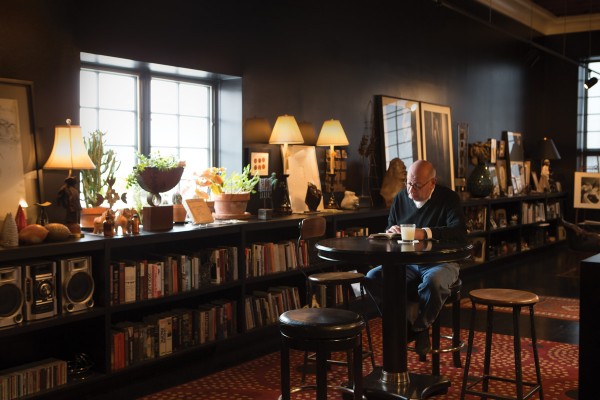The hot trend of one-room living is often driven by necessity and the need to make the most of smallish spaces. The phenomenon is especially prominent in such sky-high housing markets as New York, L.A., and San Francisco. John Prouty had no such constraints when planning his sprawling 4,000 square foot space, but he still employed a keen touch when it came to curatorial precision.“My new rule for the year is that for every one new thing I bring in,” says Prouty, “two old things need to go.” It’s a doubly vital part of his thinking, considering that his home features thousands of works of art, books, and other elements of décor, yet it bears no hint of appearing in any way cluttered.
One of the keys to Prouty’s sleight-of-hand feat is that each area of his one-room dwelling is set up to define its own distinct space within a space. The home is delineated into about a dozen distinct zones with identities and functions of their own. The result is a pronounced sense of "roomness". It is the opposite of what might be expected of an otherwise wide-open expanse beneath 19-foot ceilings. The floor plan is interrupted only by a slightly elevated but still open bedroom nook.
“I use every square inch of my space every single day,” he adds. “Not a lot of people can say that about their homes.”
Prouty and his brother, Jim, own the three contiguous buildings that they merged into one along South 25th Street in the heart of historic South Omaha. Now dubbed Prouty Place, the structures—one of them 120 years old—are almost entirely a family affair. Jim’s daughters, Jami and Juli, own the Salon at Prouty Place. Next door is home to the family’s 110-year-old business, Wessco Graphics. Prouty lives on the second floor, and the basement is rented to a Pentecostal Church whose congregation is largely Guatemalan.
 Prouty is also a sculptor, photographer, and mixed media artist who maintains his studio as part of the site’s street-level art venue called The Gallery at Prouty Place.
Prouty is also a sculptor, photographer, and mixed media artist who maintains his studio as part of the site’s street-level art venue called The Gallery at Prouty Place.
The project began seven years ago when hundreds of dumpsters were filled with the flotsam and jetsam of the former occupant, a uniform business. One year of what Prouty calls “deconstruction” yielded to a full year of construction before he moved in five years ago.
No detail was too small to escape Prouty’s systematic method when it came to the art and science of one-room living. The design process for the floating kitchen islands, for example, was governed by what the homeowner calls a “double-butted” approach. And he’s not talking here about how the kitchen’s plumbing was joined.
“My brother and I stood in while kitchen measurements were done,” he says, “and the idea was that people had to be able to easily pass between us as we stood back to back at the opposing counters preparing food or mixing drinks. Our butts were a bit smaller back then,” he quips, “but it still works just fine.”
Another striking feature of the home is the very intentional use of black paint on the walls. “People think I’m crazy,” Prouty says, “but I’ve done this in each of my last five homes. That dark background creates the illusion that the art literally floats” in a field of nothingness. The effect is particularly pronounced at night when the man who describes himself as a compulsive entertainer hosts everything from intimate soirées to fundraising events attended by a cast of thousands—make that more like 200-plus.
His global village art and artifact collection—including a staggering 93 of his own works—has been accumulated during world travels that have had him flashing a visa in 83 different countries. Acquisitions have been made everywhere from the mountaintops of Peru to the sidewalks of Paris. Also included are a number of works by local artists, perhaps most notably Terry Rosenberg. One of his six Rosenbergs was executed on an M’s Pub napkin. Prouty himself was the subject in another.
The artist’s collecting philosophy is a simple one. “Do I like it? Yes or no. Can I afford it? Yes or no,” he says. “That’s all there is to it. I never regret buying anything, and I never go back to look at something a second time. Never.”
Community involvement has always been a part of Prouty family life, says the man who serves on the City of Omaha Public Art Commission and also volunteers at Omaha South High School. His counseling role at the school has included several group art projects, and the Westside High School graduate is now proud to count himself as an honorary South High student.
“Integrating into the neighborhood is important to us,” says Prouty, who is also a member of the South Omaha Business Association. Brother Jim, who is learning Spanish, works with the Hispanic Chamber of Commerce.
“Downtown was more of a café society vibe,” Prouty says of his previous home, “but South Omaha is much more natural and organic. This is still a very urban, colorful, and bustling neighborhood— just like Downtown—but it is much more family oriented here. And much, much quieter.”
That prevailing mood of serenity sets the tone for Prouty’s contemplative, almost Zen-like approach to making his space work.
“It’s all in the editing process,” he adds. “Hey, you magazine guys must know that better than I do. It’s all about the editing.”











